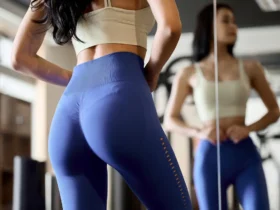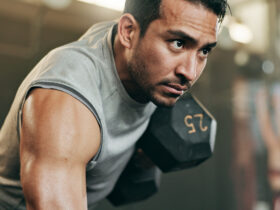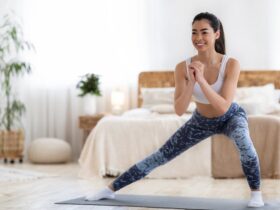Are you looking to build strong, muscular legs but don’t have access to weights?
Or perhaps you’re seeking a training method that’s easier on your joints while still delivering impactful results?
Whether you’re constrained by the equipment available, looking to mix up your fitness routine, or simply interested in exploring weight-free options, building muscular legs without traditional weightlifting is not only possible—it can be incredibly effective.
Strong legs are vital for more than just aesthetic appeal; they are essential for enhancing overall fitness, stability, and endurance, which benefits daily activities and boosts athletic performance.
Moreover, training your legs without weights can reduce the risk of injury and is often more accessible for beginners and those with physical limitations.
In this article, we will explore the top 5 alternatives to weightlifting that will strengthen and enlarge your leg muscles.
From the high-intensity bursts of plyometrics to the endurance challenge of hill training, these methods are not only diverse but are also adaptable to various fitness levels and settings.
Get ready to challenge your legs with innovative exercises that promise to deliver both strength and size, without the need for heavy lifting.
Absolutely! Here are detailed descriptions for each exercise, complete with instructions and benefits:
1. Bodyweight exercises: squats, lunges, and calf Raises
There’s a couple of exercices you can do at home without any equipment to grow serious legs, like :
- Squats: Stand with your feet shoulder-width apart. Bend your knees and lower your hips as if sitting in a chair, keeping your chest up and knees behind your toes. Rise back to the start position.
- Lunges: Stand upright, step forward with one leg, and lower your hips until both knees are bent at about a 90-degree angle. Make sure your front knee is directly above your ankle. Push back to start and repeat on the other side.
- Calf Raises: Stand on the edge of a step with your heels hanging off. Push up onto your tiptoes, hold for a moment, and then slowly lower back down.
These exercises strengthen the entire lower body, including the quadriceps, hamstrings, glutes, and calves.
Regular practice improves balance, posture, and functional strength, which are beneficial for daily activities and other sports.
Read this for more : How to grow your legs without lifting weights ? Try this bodyweight workout !
2. Plyometrics: box jumps and jump squats
Let’s keep exploring your bodyweight option with another family of exercises : plyometric !
You could do :
- Box Jumps: Stand in front of a sturdy box or platform. Perform a squat then explosively jump up onto the box. Step down carefully and repeat.
- Jump Squats:** Start in a squat position; explode upwards into a jump, and land back into the squat position. Ensure a soft landing to reduce impact on the knees.
These exercises enhance explosive power, speed, and agility by activating the fast-twitch muscle fibers in the legs.
Plyometrics improve cardiovascular health and increase metabolic rate, aiding in fat loss.
3. Running and cycling
Of course, you could also switch bodyweight exercises for cardio, popular options are :
- Running: Start with a light jog to warm up, increase to a comfortable yet challenging pace. Vary your pace and distance as you build endurance.
- Cycling: Begin with low resistance for a warm-up, then increase the resistance or speed as you progress. Intervals of high speed followed by periods of light pedaling can be very effective.
Both activities are excellent for building lower body strength, particularly in the calves, quadriceps, and glutes.
They enhance cardiovascular endurance, help in weight management, and improve overall fitness levels.
4. Hill Training
Go further combining running/cycling with hill training for maximum efficiency !
Find a hill that offers a challenging incline. Run or walk briskly uphill, then walk or jog slowly back down to recover. Repeat several times depending on your fitness level.
Hill training increases muscle strength and explosiveness in the legs due to the added resistance of the incline.
It also boosts cardiovascular strength and can help improve running form and efficiency.
5. Bodyweight resistance training: resistance bands, TRX
Weights are not the only tools to add resistance to your training, you could also benefit from basic accessories like :
- Resistance Bands: Use bands around your legs to add resistance during squats, lunges, or leg lifts.
- TRX: Use suspension straps to perform squats, lunges, and other leg exercises. The instability of the straps increases the difficulty and engages more muscle groups.
These tools add resistance without weights, increasing muscle activation and growth.
They also improve muscular endurance and can be used to add variety to your workout, reducing the risk of plateaus.
By incorporating these exercises into a regular workout regimen, you can achieve significant improvements in leg strength and size without traditional weightlifting equipment.
Each exercise has unique benefits, making them suitable for a variety of fitness goals.
While weightlifting is a popular way to build leg muscles, it is not the only way. Incorporating a variety of exercises and activities can help build strength and muscle in the legs.
However, it is important to ensure that any exercise program is safe and effective, and consulting with a fitness professional can help ensure that you are doing exercises properly and getting the most out of your workouts.
Takeaway
As we’ve explored various effective exercises and techniques for building leg strength and muscle without lifting traditional weights, here are some key points to keep in mind as you incorporate these methods into your fitness routine:
- Variety is Key : Mixing different types of exercises, such as bodyweight routines, plyometrics, and cardiovascular activities like running or cycling, can prevent boredom and stimulate different muscle groups for balanced growth.
- Consistency is Crucial: To see results, consistency in your workouts is essential. Aim to train your legs at least 2-3 times per week, progressively increasing the intensity and complexity of the exercises as your strength improves.
- Proper Form Matters: Focus on maintaining proper form to maximize the effectiveness of each exercise and minimize the risk of injury. It’s better to do fewer repetitions correctly than to do many with poor form.
- Nutrition and Recovery: Support your exercise regimen with a balanced diet rich in protein, healthy fats, and carbohydrates for muscle repair and growth. Additionally, ensure adequate rest and recovery by getting enough sleep and scheduling rest days into your workout plan.
- Adjustments and Progressions: As you become more comfortable with the exercises, continue to challenge your muscles by adding more repetitions, increasing the speed or intensity, or incorporating resistance bands and other tools to further enhance muscle growth.
- Listen to Your Body: Pay attention to how your body responds to the workouts. If you experience pain beyond normal muscle soreness, adjust your exercise routine and consider consulting with a fitness professional.
By following these guidelines, you’ll be well on your way to developing strong, muscular legs without the need for heavy weights. Remember, the journey to building muscle is a marathon, not a sprint; patience and persistence will be your best assets. Happy training!







